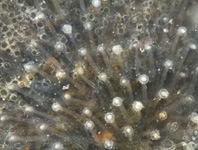Abstract
A new cricket of the genus Scapsipedus is described from Kenya. The distribution, acoustic behavior, including call and courtship song, mitochondrial sequences, and data on the biology of that new species are given. This edible cricket is a very promising species for mass production for food and feed.
References
Ayieko, M.A., Ogola, H.J. & Ayieko, I.A. (2015) Introducing rearing crickets (gryllids) at household levels: adoption, processing and nutritional values. Journal of Insects as Food and Feed, 2 (3), 203–211.
https://doi.org/10.3920/JIFF2015.0080
Chopard, L. (1934) Catalogues raisonnés de la faune entomologique du Congo belge. Orthoptères Gryllides. Annales du Musée du Congo belge Tervueren (Belgique), Zoologie, 3, Sect. 2 4, 1–88.
Chopard, L. (1954) Orthoptera-Ensifera from Kenya and Jubaland. Transactions of the Royal Entomological Society of London, London, 105 pp.
Chopard, L. (1962) Orthoptères Gryllidae et Gryllacrididae de l'Angola. Publicações Culturais da Companhia de Diamantes de Angola, 56, 13–69.
Gorochov, A.V. (1988) New and little known tropical Grylloidea (Orthoptera). Proceedings of the Zoological Institute (USSR Academy of Sciences), 178, 3–31. [in Russian]
Gorochov, A.V. (1993) Grylloidea (Orthoptera) of Saudi Arabia and adjacent countries. Fauna of Saudi Arabia, 13, 79–97.
Hajibabaei, M., Janzen, D.H., Burns, J.M., Hallwachs, W. & Hebert, P.D.N. (2006) DNA barcodes distinguish species of tropical Lepidoptera. PNAS, 103, 968–971.
https://doi.org/10.1073/pnas.0510466103
Kearse, M., Moir, R., Wilson, A., Stones-Havas, S., Cheung, M., Sturrock, S., Buxton, S., Cooper, A., Markowitz, S., Duran, C., Thierer, T., Ashton, B., Mentjies, P. & Drummond, A. (2012) Geneious Basic: an integrated and extendable desktop software platform for the organization and analysis of sequence data. Bioinformatics, 28 (12), 1647–1649.
https://doi.org/10.1093/bioinformatics/bts199
Kimura, M. (1980) A simple method for estimating evolutionary rate of base substitutions through comparative studies of nucleotide sequences. Journal of Molecular Evolution, 16, 111–120.
https://doi.org/10.1007/BF01731581
Kumar, S., Stecher, G. & Tamura, K. (2016) MEGA 7: Molecular Evolutionary Genetics Analysis version 7.0 for bigger datasets. Molecular Biology and Evolution, 33, 1870–1874.
https://doi.org/10.1093/molbev/msw054
Lundy, M.E. & Parrella, M.P. (2015) Crickets Are Not a Free Lunch: Protein Capture from Scalable Organic Side-Streams via High-Density Populations of Acheta domesticus. PLoS ONE, 10 (4), e0118785.
https://doi.org/10.1371/journal.pone.0118785
Thompson, J.D., Gibson, T.J., Plewniak, F.J, Jeanmougin, F. & Higgins, D.G. (1997) The CLUSTAL_X windows interface: flexible strategies for multiple sequence alignment aided by quality analysis tool. Nucleic Acids Research, 25 (24), 4876–4882.
https://doi.org/10.1287/inte.27.4.1
van Huis, A. (2013) Potential of insects as food and feed in assuring food security. Annual Review of Entomology; 58, 563–583.
https://doi.org/10.1146/annurev-ento-120811-153704

